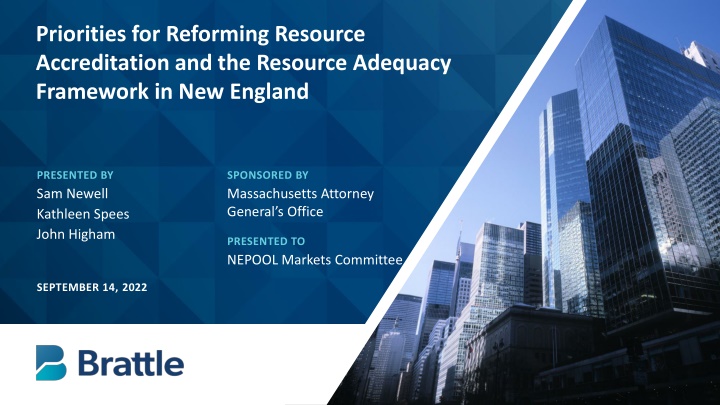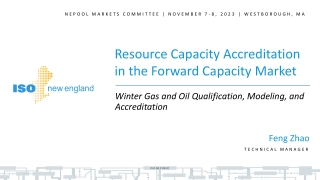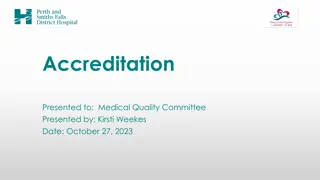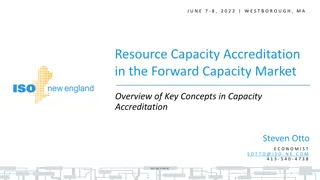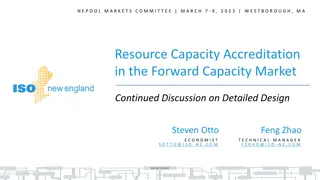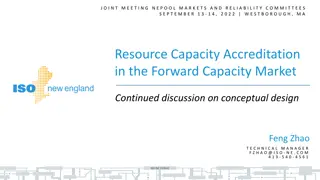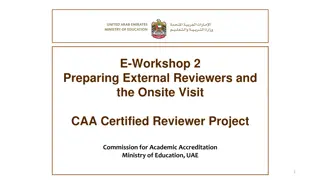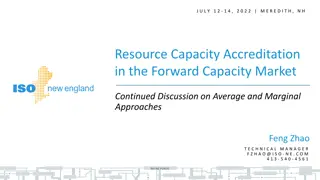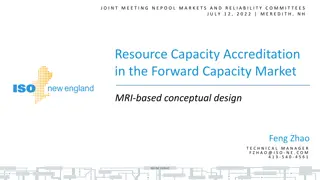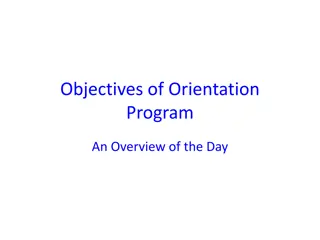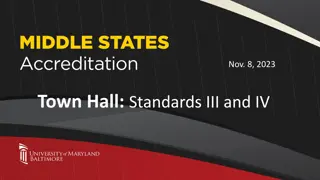Priorities for Reforming Resource Accreditation in New England
Presentation by Sam Newell, Kathleen Spees, and John Higham sponsored by Massachusetts Attorney General's Office on reforming resource accreditation and the resource adequacy framework in New England. The discussion focuses on the primacy of winter risks, the need for broad reform beyond accreditation, and addressing supply risks to ensure winter adequacy.
Download Presentation

Please find below an Image/Link to download the presentation.
The content on the website is provided AS IS for your information and personal use only. It may not be sold, licensed, or shared on other websites without obtaining consent from the author.If you encounter any issues during the download, it is possible that the publisher has removed the file from their server.
You are allowed to download the files provided on this website for personal or commercial use, subject to the condition that they are used lawfully. All files are the property of their respective owners.
The content on the website is provided AS IS for your information and personal use only. It may not be sold, licensed, or shared on other websites without obtaining consent from the author.
E N D
Presentation Transcript
Priorities for Reforming Resource Accreditation and the Resource Adequacy Framework in New England PRESENTED BY Sam Newell Kathleen Spees John Higham SPONSORED BY Massachusetts Attorney General s Office PRESENTED TO NEPOOL Markets Committee SEPTEMBER 14, 2022
Introduction Comments today derive from two Brattle reports for MA AGO See full reports at: Capacity Resource Accreditation for New England s Clean Energy Transition brattle.com | 1
Accreditation is only one part of ISO-NEs RA Framework Accreditation is only one part of ISO-NE s resource adequacy framework, whose goal is to ensure adequate supply cost effectively The resource adequacy construct has five components: Setting of a reliability standard (i.e., 0.1 LOLE) Probabilistic analysis of the risks of having insufficient supply available to meet demand Leveraging the analysis to set required reserve margins (RMs) to meet the reliability standard Leveraging the analysis to accredit resources for their contributions (and conforming the RM requirements themselves to the aggregate accreditation of the modeled adequate fleet) Holding capacity auctions to commit the most cost-effective set of resources to meet the required RMs (more or less, along the demand curve) brattle.com | 2
The Primacy of Winter Risks in New England In New England, winter cold snaps present the greatest risks of shortage ISO-NE management emphasizes this topic OFSA and subsequent analyses illustrate risks Summer reserve margins remain high Intermittent resources are still a small fraction of total supply Winter resource adequacy and availability should be addressed in the resource adequacy framework (even if also addressed through other means) To support necessary and cost-effective resource investments/retentions To support necessary and cost-effective fuel arrangements, maintenance, and operational improvements among resources This is more than just a gas pipeline and LNG problem for the states to solve brattle.com | 3
The Need for Broad Reform, not just Accreditation ISO-NE s current framework does not sufficiently address winter supply risks and could make them worse Needed reforms: Improve modeling of winter risks Current modeling barely captures winter risks and may still not after the current initiative unless ISO-NE prioritizes it That will enable more accurate RA requirements and accreditations (esp. if implemented along with other accreditation principles discussed on later slides) Until winter risks are fully incorporated into requirements and accreditation, there is no assurance of winter adequacy And resource accreditations may be distorted in ways that could worsen the problem A summer-focused risk analysis with limited winter fuel modeling over-credits non-firm gas resources This can distort the fleet toward non-firm gas and away from LNG, oil, nuclear, renewable and other resources that can help This could worsen winter risks The resulting needs and capabilities/obligations can best by served through seasonal (winter/summer) requirements and auctions If the current Resource Capacity Accreditation initiative derates wind, solar, and storage without sufficiently addressing winter risks, that could further shift the resource mix toward over-rated non-firm gas Continuing a (summer-focused) annual framework distracts from and obscures the real problem brattle.com | 4
ACCREDITATION PRINCIPLES Accreditation Principles Accurate accreditation is needed to verify adequate total supply to meet reliability objectives Verify Adequate Total Supply Accurate accreditation can establish RA-neutral exchange rates among resources to govern resource substitutions and signal economically efficient investment Accreditation may also incentivize resource performance Signal Reliability-Neutral Resource Substitutions and Economically Efficient Investment Incentivize Resource Performance Brattle.com | 5
Marginal Accreditationif Applied Accurately across ALL Resource Types Best Supports RA-Neutral Exchange Rates Marginal capacity accreditation can ensure all accredited MW are equivalent w.r.t. marginal substitutions of resources in the pre-auction and investment timeframes. Marginal accreditation supports reliable substitutionsof resources between the time of the study setting of requirements and accreditations (with an assumed fleet) and the auction (whose composition may differ) Reliable Substitutions but only if the accreditation captures the value for all resource types Marginal accreditation supports efficient investment and retirement, per economic and optimization theory, by properly compensates resources for their value when risk/value is greatest Adequate and Efficient Investment but only if the accreditation accurately captures the value of all resource types As for arguments that marginal accreditation is unfair: it is as fair as an ideal energy-only market and other markets Energy-only rewards capacity when supplies are tight (e.g., a high-PV system will depress daytime prices for all resources, even those built first ). Recognizes that in a world where meeting demand at a particular time is easy (e.g., summer afternoons in a high-PV system), additional capacity at that time provides little additional value, even if we value reliability equally in all periods. Just like any market to reward marginal value; and at equilibrium, the price equals long-run marginal costs (LRMC) incl. capital costs. Note that this does not exploit suppliers sunk costs. It still pays the full LRMC in equilibrium. The reason revenues decline is that suppliers keep adding capacity, presumably because the LRMC of such capacity has fallen, net of energy and environmental value. brattle.com | 6
Achieving Accurate, RA-Neutral Exchange Rates Requires Accounting for Different Risks Across Resource Types, and Individual Performance Drivers of Unavailability Affecting Resource Adequacy Value Different resource types have very different patterns of (un)availability during risky periods, especially if their unavailability is causing the risk Gas w/some firm fuel High Patterns of unavailability are driven by both exogenous factors and management factors Non-firm Gas Oil Dependence on Factors under Management Control (may depend on fuel characteristics; performance may be observed as in tightest periods) Hybrids Battery Storage Most resources are affected by both, to different degrees and in different ways DR Wind PV This suggests for all resources: Consideration of operating characteristics against a broad range of exogenous conditions Low Low High Ability to capture the effect of extreme conditions on each resource types value Dependence on Exogenous Factors (e.g., weather, time of day; can be studied by observing and/or modeling many years of weather in how availability coincides with shortage risk) Observation of actual performance brattle.com | 7 brattle.com | 7
Empiricism and Modeling Approaches Are Both Needed EMPIRICISM HYBRID EMPIRICISM + MODELING MODELING APPROACH: INDIVIDUAL AVAILABILITY, AND MODELED CLASS-WIDE MARGINAL ELCC APPROACH: INDIVIDUAL AVAILABILITY DURING TIGHT INTERVALS IN RECENT YEARS APPROACH: MARGINAL ELCC ELCC calculated by probabilistically modeling resources reliability contributions by simulating distribution of weather years and outages; but still adjusting for observed individual performance in tight hours, as in MISO s thermal approach or PJM s final factor Probabilistically simulates resources contributions to reliability over broad distribution of weather years Each resource s average observed availability during intervals with lowest supply cushion during previous ~3 years ADVANTAGES ADVANTAGES ADVANTAGES Combines recent real-world data with broadest distribution of modeled weather-driven performance (with data-driven and/or fundamental modeling of how resources with specified characteristics perform under such conditions) Simple and transparent, based on real-world data Accounts for weather-driven performance over a broad distribution of weather patterns Recent data most indicative of current resource management/age/conditions Enables risk weighting for expected reliability value Incentivizes resource performance Enables risk-weighting for expected contribution to reliability LIMITATIONS LIMITATIONS LIMITATIONS Not risk-weighted, biases accreditation upward for resources that are less available in the tightest conditions Electricity systems are complex, and modeling is imperfect. Conditions vary, data is limited, and modeling is imperfect. Challenging to capture management factors esp. to model thermal resources under stress conditions not recently observed Tradeoff between using few hours (more reflective of shortage conditions) vs. more hours (more forgiving of bad luck ) Challenging to model thermal resource performance under stress conditions not recently or often observed Tradeoff between having more years of data (broader distribution of weather) vs. just recent years (reflects current asset conditions) Sensitive to modeling judgements Sensitive to modeling judgements brattle.com | 8
IMPLEMENTATION Why a Seasonal Framework is Needed (on Top of Better Risk Analysis and Accreditation Process) If assessed risks are primarily in winter, setting annual requirements and accreditations could have unintended consequences Summer-focused resources will be heavily de- rated, increasing their cost per accredited MW, so they may not clear, perhaps leading to summer shortages that the risk analysis missed Those risks (or any other summer risks not modeled) might not be covered because: Accreditations underemphasize summer Total CSOs will be less than peak load Separating the framework into two seasons avoids having total CSO < peak load This occurs when using marginal MRI because total CSOs = simulated load when shortages occur, which is in the winter at 2/3 summer peak Allocation of Net CONE and price caps between seasons fits perfectly into the MRI framework, where WTP per unit of avoided EUE is the same across seasons This could lead to awkward uncovered situation (see right) and/or having to scale up CSOs beyond some resources capabilities, through the balancing ratio Brattle.com | 9
KEY TAKEAWAYS Summary of Priorities Improve modeling to capture winter risks Adopt a seasonal capacity market to address winter reliability threats Enhance accreditation for all resources, including thermal plants Pursue marginal value-based accreditation to provide resource-adequacy-neutral exchange rate and incentives for efficient investment (but only if applied to all resources) Develop hybrid concept that combines probabilistic modeling and empirical approaches Plan to iteratively refine the approaches Brattle.com | 10
